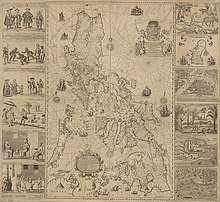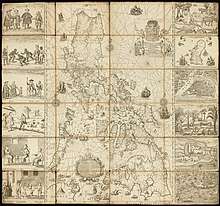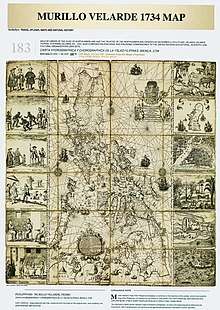Velarde map
Carta Hydrographica y Chorographica de las Islas Filipinas (Spanish, "Hydrographical and Chorographical Chart of the Philippine Islands"), more commonly known as the Murillo Velarde map, is a map of the Philippines made and first published in Manila in 1734 by the Spanish Jesuit cartographer Pedro Murillo Velarde, and two Filipinos; engraver Nicolás de la Cruz Bagay and artist Francisco Suarez.[2][3] The World Digital Library describes it as the "first and most important scientific map of the Philippines".[4] It is frequently referred to as the "Mother of all Philippine Maps".[5][1][6]


.jpg)

During the British Occupation of Manila, the copper plates used to print the map were seized and transported to England where they were used to produce multiple copies of the map before the plates were destroyed and reused.[7] Many of the most famous and expensive copies were from this re-printing.
Map
The map's title includes the following additional description: dedicada al Rey Nuestro Señor por el Mariscal d. Campo D. Fernando Valdes Tamon Cavallo del Orden de Santiago de Govor. Y Capn General de dichas Yslas (Spanish, "dedicated to the King Our Lord by Field Marshal Fernando Tamon Valdes, Knight of the Order of Santiago, Governor and Captain General of said Islands"). The map was created upon the behest of then governor-general Fernando Valdes y Tamon in response to an order from Philip V of Spain.[8]
The map shows maritime routes from Manila to Spain and New Spain. The Spanish royal coat of arms occupies a prominent space in the upper-middle portion of the map. On its flanks are twelve images, six to a side. Eight of these images depict various ethnic groups residing in the archipelago. The remaining four are cartographic depictions of cities and islands. The ethnic groups and individuals depicted include Chinese Filipinos ("Sangley") or Chinese, Cafres or East Africans brought to Manila slave market by Portuguese, a Canarin (a native of India on the Konkani coast, most likely a Goan or Mangalorean), a Lascar from India, mestizos, a Mardica (natives of Ternate and Tidore), a Japanese ("Japon"), Spaniards, Criollos, Filipino natives ("Indios"), Aetas, an Armenian, a Mughal, a native of the Malabar region and a Visayan. Maps of "Samboagan" (known today as Zamboanga City, a city in Mindanao), the port of Cavite, the island of "Guajan" (Guam) and Manila, and illustrations of endemic plants and animals occupy the remaining sections.
The Murillo Velarde map was widely reprinted. These include reproductions in Manila (1744), Vienna (1748) by Kaliwoda, Nuremberg (1760) by Lowitz, and in the first volume of Juan de la Concepcion's Historia General de Philipinas (1788).[8]
Copies
There are less than 50 extant copies of the map.[9] Some are mounted on a cloth backing measuring 112x120 cm. The map itself measures 108x71 cm and is on a scale approximating 1:1,400,000.
- The American Library of Congress Geography and Map Division in Washington, D.C. has one copy of the original 1734 printing, Call No. G8060 1734 .M8.[2]
- The National Library of Spain in Madrid has one copy of the original 1734 printing, Call No. MR/45/31.[10]
- The National Library of France has a copy.[11]
- There is one copy in a private collection in the Philippines.[9]
- In 2014 the Duke of Northumberland, Ralph Percy had a copy of the map auctioned off by Sotheby's. Filipino businessman Mel Velarde won the auction, paying £170,500.00[9] (approximately ₱12 million) for it.[12] This copy had been printed by the British using the 8 original Murillo Velarde copperplates which had been looted from Manila by William Draper during the British occupation of Manila in 1762. Draper donated the plates to Cambridge University and the university printed copies of the map, one of which later came into the possession of the Duke of Northumberland of the late 18th century. The British however, later melted down the copperplates and reused the metal in printing their Admiralty charts.[5] Velarde donated the map to the National Museum of the Philippines in 2017.[13]
- In 2019, a copy of the 18th Century British printing was purchased at an auction in the Philippines for 40 million Philippine pesos (US$793,651), significantly more than the pre-auction estimate of 18 million pesos, by an unnamed Chinese Filipino buyer.[7] This map was part of an unspecified private collection and one of at least three such versions currently in private collections in the Philippines.[11]
Reduced version
Murillo Velarde also published a smaller version of the Carta Hydrographica y Chorographica de las Yslas Filipinas, one that did not include the twelve illustrations on the map's flanks. This version measures 51x33 cm. and was published in 1744.[6] There are extant copies in the collections of the Lopez Museum, National Library of the Philippines[9] and the Boston Public Library Norman B. Leventhal Map Center.[14]
South China Sea disputes
The Murillo Velarde map has been instrumental in the Philippines' efforts to assert territorial rights in the South China Sea. The map, along with 270 other maps, was used by the Philippines' team of experts to refute China's historic claim of ownership of the entire South China Sea,[13] as it features Scarborough Shoal then labelled as "Panacot", as well as "Los Bajos de Paragua" now known as the Spratly Islands.[15] In 2016 the Permanent Court of Arbitration ruled in favor of the Philippines stating that China had "no historical rights" based on their Nine-Dash Line map. China however, rejected the ruling,[16] and Philippine President Rodrigo Duterte has decided not to act upon it.[17]
References
- Mariano, Jose Vionel F. (30 August 2017). "Army receives replica of Mother of all Philippine Maps". Philippine Army. Retrieved 4 January 2018.
- "Carta hydrographica y chorographica de las Yslas Filipinas : dedicada al Rey Nuestro Señor por el Mariscal d. Campo D. Fernando Valdes Tamon Cavallo del Orden de Santiago de Govor. Y Capn". Library of Congress. Retrieved 4 January 2019.
- "Chairman Velarde donates replicas of 1734 Murillo-Velarde Map". Asian Institute of Journalism and Communication. Retrieved 4 January 2018.
- "A Hydrographical and Chorographical Chart of the Philippine Islands". World Digital Library. 8 January 2018. Retrieved 4 January 2019.
- "We Have the Mysterious Map that Proves the West Philippine Sea is Ours". Esquire Philippines. 4 May 2017. Retrieved 4 January 2019.
- "The Mother of Philippine Maps". Lopez Museum. 9 November 2009. Retrieved 4 January 2019.
- "Rare map that bolstered Philippines' case in territorial dispute with China sold for $1 million". The Straits Times. 15 September 2019. Retrieved 16 September 2019.
- Mojarro, Jorge R. (12 June 2015). "The Murillo Velarde map: A relic from 1734 amid the rough seas of 2015". BusinessWorld. Retrieved 4 January 2019.
- Ocampo, Ambeth R. (10 June 2015). "Rare, important and significant". The Philippine Daily Inquirer. Retrieved 4 January 2019.
- "Carta Hydrographica y Chorographica de las Yslas Filipinas Dedicada al Rey Nuestro Señor por el Mariscal d. Campo D. Fernando Valdes Tamon Cavallº del Orden de Santiago de Govor. Y Capn. Hecha pr. el Pe. Pedro Murillo Velarde dla. Compª d. Ihs. Cathco. d. De Canones sobre los Mapas y Relaciones mejores que han salido, y observaciones del Author ; delineavit Nicolas de la Cruz Bagay Indio [Tagalo en Manl. Año 1734]". Retrieved 4 January 2019.
- "The Extraordinarily Important and Exceedingly Rare Murillo Velarde Map of 1734". Leon Gallery. Retrieved 16 September 2019.
- Tordesillas, Ellen T. (7 June 2015). "PH to submit 300-year-old map to UN in case vs China". Retrieved 4 January 2019.
- "UPD gets replica of 1734 Murillo Velarde map". University of the Philippines Diliman. 18 October 2018. Retrieved 4 January 2019.
- "Mapa de las yslas Philipinas". Boston Public Library. Retrieved 5 January 2019.
- Layug, Margaret Claire (11 September 2017). "Murillo Velarde Map refutes 'false history', China's claims – Carpio". GMA News. Retrieved 4 January 2019.
- Phillips, Tom (12 July 2016). "Beijing rejects tribunal's ruling in South China Sea case". The Guardian. Retrieved 4 January 2019.
- Salaverria, Leila B. (18 December 2016). "Duterte to set aside UN tribunal ruling on maritime dispute". Philippine Daily Inquirer. Retrieved 4 January 2019.
External links
| Wikimedia Commons has media related to Carta Hydrographica y Chorographica de las Yslas Filipinas. |
| Wikimedia Commons has media related to Mapa de las yslas Philipinas. |